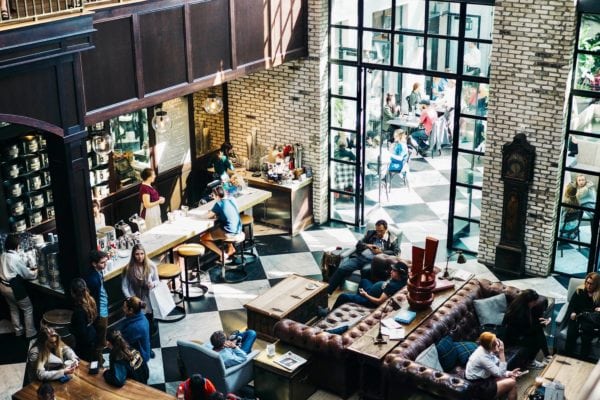Skift Take
In Charleston, S.C. restaurant partners Brooks Reitz and Tim Mink are creating restaurants with much more in mind than just food.
— Stephanie Burt
Those in the restaurant business know the division well: there are diners who go to restaurants to eat food that they cannot or would not prefer to make at home, and then there are those who want a restaurant experience.
For the latter, it is about transcending beyond everyday eating habits and instead enjoying an immersion of setting, service, food and drink all combining into something that is more than just the food on the plate. And for those diners, a reservation at one of the restaurants of Brooks Reitz and Tim Mink in Charleston, S.C. is a promise of just such an experience.
“For us, in designing, it’s all about that vibe,” says Reitz. “That, and a certain level of finish, a certain glow.”
The duo have created Leon’s Oyster Shop, Little Jack’s Tavern, Melfi’s, and are now in the process of reimaging and revamping one of Mink’s earlier projects — Monza (although it is remaining open while the team works behind the scenes). They are not professionally trained interior designers or restaurant architects, but instead restaurant enthusiasts who met and became friends in the Charleston food scene. They soon realized their shared interest in restaurant design and planning, and it led them to become business partners as well as friends.
“We realized that design as an ingredient could give you an upper hand for success, actually diversify opportunities for success within a restaurant,” Reitz explains. “I’m a front of house guy, not a chef, so if the chef of my restaurant leaves, it is going to go through some inconsistency. I started asking, ‘What could I control, could manage that could stay consistent?’ That is the look and feel of the place, the vibe. With the right one, maybe customers are a little more fogiving if something isn’t quite right, and maybe they embrace you as a restaurant a little faster.”
All of these spots (excepting Monza) occupy the same block, and they are more than just a “retro journey.” Each one is a unique, almost virtual reality step into someplace else, be it Leon’s, a deep South oyster dive bar that seems like it could be a juke joint after hours, to Little Jack’s, which seems to be plucked from a neigborhood that existed in driving distance to Manhattan, sometime around 1958-62.
These restaurants don’t necessarily offer what many might term an “Epcot” experience (recreating another country) but more of a transport — with a wink — into a place outside of time, since each menu does feature throwback classics but also modern dishes and preps. For example, at Little Jack’s, a wedge salad or pastrami on rye is juxtaopsed with other offerings of salmon with farro or the ubiquotous modern side: roasted brussels sprouts.
Design First
But it’s the complex layering of design that really makes this duo’s projects shine. From fonts on menus to music to the cut of a banquette to how glassware feels in the hand to language on the restaurant’s website, each experience is complex and designed in the details. “We are trying to make escapist places, the best places for our customers where they can be transported from everyday stresses,” he says.
As for how the magic comes together, Reitz asserts that it’s a lot more organic and a lot less organized than he wish it were, but that it is also part of the fun. The two often travel together, and when they don’t, they share ideas. Recently, Reitz has began using Evernote to help track those ideas, but he readily admits that he still relies mostly on his almost photographic memory that allows him not only to remember faces and names (both good things for front-of-house hospitality), but also the glassware in the natural wine bars he and his wife frequented while on honeymoon in Copenhagen. “I’m able to recall restaurant details, google it, capture that image, and show it to the team.”
Nevertheless, it’s really only in the final weeks of a project that one of their restaurants come together. For Melfi’s, their most recent restaurant opening, they were changing out light bulbs throughout the first week after experiencing the restaurant “live” during preview dinners. And they also called in an electrictian to add LED lighting behind booths so they would have a soft backlit glow. It became that cohesive, allusive “vibe” and recently Melfi’s was nominated for one of the most beautiful restaurants of the year for Eater Charleston. Simply, it’s just a hot place to be in a city filled with them.
He says, “You need to be living in a space for a while to see what it needs. There is no specific structure around what we do, but we really like doing it. We like to say that we are the king of the change order, but when it’s right, it comes together.” And any visit to “Brooks’ block” of King Street on a Saturday night, and those joints are hopping. That’s the transformation of a neighborhood, not just of a dining experience.
Stephanie Burt is the host and producer of The Southern Fork podcast and a writer based in Charleston, SC. Her work has appeared in Saveur, Roads & Kingdoms, Conde Nast Traveler, Gravy, and Paste, and she focuses on researching heirloom ingredients, interviewing passionate people creating good food, and when she’s in the kitchen, perfecting her roasted chicken recipe.


